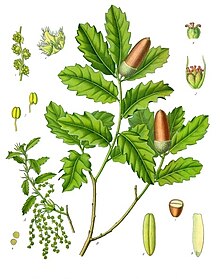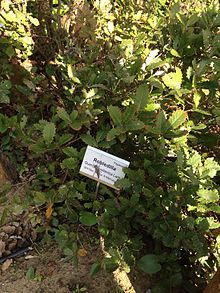| Gall oak | |
|---|---|

| |
| 1897 illustration from Franz Eugen Köhler, Köhler's Medizinal-Pflanzen | |
| Conservation status | |
 Least Concern (IUCN 3.1) | |
| Scientific classification | |
| Kingdom: | Plantae |
| Clade: | Tracheophytes |
| Clade: | Angiosperms |
| Clade: | Eudicots |
| Clade: | Rosids |
| Order: | Fagales |
| Family: | Fagaceae |
| Genus: | Quercus |
| Subgenus: | Quercus subg. Quercus |
| Section: | Quercus sect. Quercus |
| Species: | Q. lusitanica |
| Binomial name | |
| Quercus lusitanica Lam. | |
| Synonyms | |
List
| |
Quercus lusitanica, commonly known as gall oak, Lusitanian oak, or dyer's oak, is a species of oak native to Portugal, Spain (Galicia and western Andalucia) and Morocco. Quercus lusitanica is the source of commercial nutgalls. These galls are produced by the infection from the insect Cynips gallae tinctoriae. They are used for dyeing.
Several other species are known colloquially as "gall oaks;" indeed, galls can be found on a large percentage of oak species. The specific epithet "lusitanica" refers to the ancient Roman Province of Lusitania, corresponding roughly to present-day Portugal and Extremadura in Spain.
Description

Quercus lusitanica is a large semi-deciduous tree 10-15m in Height,
Taxonomy
It was incorrectly named Q. humilis, later Q. fruticosa and its current name was incorrectly used to identify other Gall oaks from the Iberian Peninsula and North Africa. This resulted in numerous taxonomy errors in the Gall oaks taxa from the occidental and oriental Mediterranean Basin.
Distribution and habitat
Quercus lusitanica is native to the Iberian Peninsula (in Portugal and western Andalusia, Spain, also rare on Galicia) and Morocco It is commonly associated in oak and pine forests and does well in acidic soils. It favors mild coastal Mediterranean climates but it also succeeds in moist, mild, maritime climates. It is relatively sensitive to cold temperatures and is hardy down to −8 °C (18 °F). It inhabits sandy or gravelly soils up to 600 m (2,000 ft) in elevation.
Threats
No serious threats were found in Portugal, though in Andalusia this plant has been listed as Near Threatened due to fires, silviculture and grazing ungulates. The main threat to the conservation of genetic diversity of this species is the hybridization with the oak neighbors (Holm Oak, Cork Oak, Kermes Oak, Pyrenean Oak).
References
- ^ Jerome, D.; Vazquez, F. (2018). "Quercus lusitanica". IUCN Red List of Threatened Species. 2018: e.T79914375A103229340. doi:10.2305/IUCN.UK.2018-2.RLTS.T79914375A103229340.en. Retrieved 19 November 2021.
- "Quercus lusitanica Lam.". World Checklist of Selected Plant Families. Royal Botanic Gardens, Kew – via The Plant List. Note that this website has been superseded by World Flora Online
- ‹ The template below (WCSP) is being considered for deletion. See templates for discussion to help reach a consensus. ›
"Quercus lusitanica". World Checklist of Selected Plant Families (WCSP). Royal Botanic Gardens, Kew.
- Cranshaw, Whitney (2004). Garden Insects of North America. Princeton, New Jersey: Princeton University Press. ISBN 0-691-09560-4.
- Garcia, José Manuel (1989). História de Portugal: Uma Visão Global. Lisboa: Editorial Presença. pp. 32, 33, 38. ISBN 9722309897.
- ^ "Quercus lusitanica" (PDF). Flora Iberica. Retrieved 20 January 2021.
- ^ "Quercus lusitanica". Temperate Plants Database, Ken Fern. Retrieved 20 January 2021.
- "Quercus lusitanica Lam". Flora-on. Retrieved 21 January 2021.
- Harvey-Brown, Y. (2017). "Quercus lusitanica". IUCN Red List of Threatened Species. 2017: e.T79914375A79914412. Retrieved 20 January 2021.
| Sources of tannins | |||||||||||||||||
|---|---|---|---|---|---|---|---|---|---|---|---|---|---|---|---|---|---|
| Sources of condensed tannins |
| ||||||||||||||||
| Sources of hydrolysable tannins |
| ||||||||||||||||
| Other sources by organ |
| ||||||||||||||||
| Taxon identifiers | |
|---|---|
| Quercus lusitanica |
|
This article about plants in the genus Quercus is a stub. You can help Misplaced Pages by expanding it. |